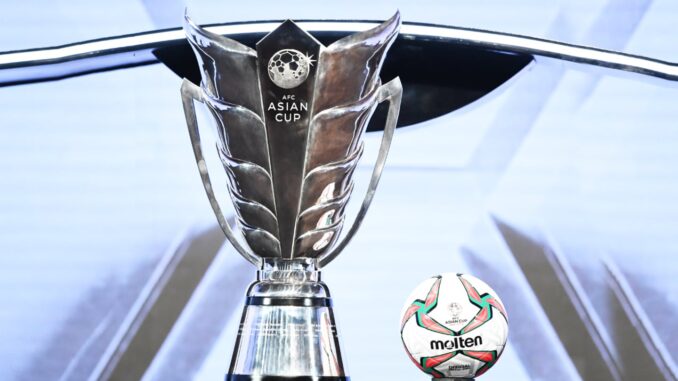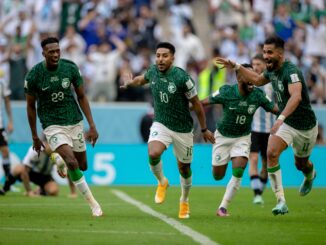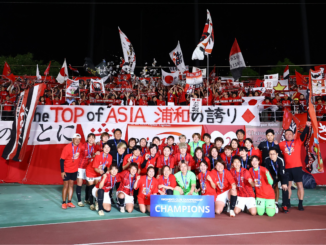
The path to the upcoming AFC Asian Cup 2023 has been far from a smooth one, but after riding the waves of a global pandemic, team withdrawals and a late hosting switch, Thursday’s group stage draw finally arrives to relieve the few years of madness that preceded it.
As it stands, January’s rescheduled tournament may in the end feel a little inconvenient. The move to the northern hemisphere winter will predictably be followed by groans from any European club having to part with their prized Asian asset midway through a domestic league campaign.
Meanwhile it’s positioning in the Asian calendar is going to feel a tad out of place, given qualification for the 2027 edition will have started four months previous.
Mitigations aside, this Asian Cup is set to take place at a pivotal time in the continent’s footballing history. Following Asia’s most successful World Cup on record, a second expanded Asian Cup offers another opportunity for further development across Asian football ahead of the doubling of World Cup qualification slots for the World Cup in USA, Mexico and Canada in three years’ time.
With nearly a year already without competitive football for most, there promises to be more unpredictability on the pitch heading into the finals than usual.
Ahead of the draw, the pots already allude to potential shock and surprise, as twenty-four teams gear up for the AFC’s 18th Asian Cup.
In a two-part series we’ll look over each pot and how each nation is shaping up ahead of the tournament.
Part One focuses on teams in Pots 1 & 2, while Part Two (to be released tomorrow) will focus on Pots 3 & 4.
Asia’s big six with hopes of continental silverware
Pot 1 – Qatar, Japan, Iran, South Korea, Australia, Saudi Arabia
Less than six months on from a historic World Cup for Asia, the ‘Big 6’ of the continent return to their own backyard in more evolutionary mood than we may have expected back in November, with four of the six due to go into the upcoming Asian Cup with a new coach in place.
Japan, probably the most eye-catching of performers in Qatar, are one of the two who have chosen to retain their coach heading into a tournament, with the aim to return to the top of the pile continentally, at a tournament in which they haven’t tasted glory for over a decade.
The optimism that came with victories over Germany and Spain, however, is tempered by concerns Japanese fans may have with Hajime Moriyasu’s approach. Reactive, counter-attacking tactics that worked their magic, at times fortuitously, against the very best in the world may prove less impactful when they’re presented with opponents sitting deep from the outset.
Embed from Getty ImagesHeading into the Asian Cup, Moriyasu also has to consider whether to stick or twist; a familiar conundrum facing most at the tournament, of whether to treat this as the culmination of a cycle, which started at the last Asian Cup, or as the start of a new generation given the greater guarantees of qualification for 2026.
Moriyasu has already looked at strengthening the depth of his squad in March’s recent international friendlies. There were no signs of Shuichi Gonda, Hiroki Sakai or Maya Yoshida; players who were integral for the Samurai Blue in Qatar. But whether that’ll be replicated in their return to Qatar may determine whether it’s one last go at glory, or the start of a very different phase of their evolution.
Australia, the other side to have retained their coach following the World Cup, have arguably already undergone much of their very own redevelopment, having withstood the reality check of barely scraping through to Qatar last year, before they grew into the tournament proper.
Any doubts over the quality in this Socceroos camp were emphatically answered six months ago; yet there feels like some nagging question marks still hang over the squad, in particular in central midfield and attack, if they are going on to replicate the scenes of their 2015 triumph.
The emergence of youth, in the shape primarily of Garang Kuol, despite having a tough time in Europe since his initial breakthrough, may become the dominant narrative surrounding Graham Arnold’s side’s in the lead up to the event, where they’ll undoubtedly be billed as one of the top few candidates for continental glory.
Embed from Getty ImagesThey’ll be joined in that regard by Iran, who unquestionably have a focus on lifting their first Asian Cup since the 1970s.
With the oldest squad at the World Cup, the need for evolution is a growing necessity; but for now, with Ghalenoei only granted a contract until the end of the Asian Cup, trusting in what currently works, inevitably still playing in Carlos Queiroz’s departed shadow, may be the best route to bring them success.
With little expected to change in approach or personnel, momentum may become the crucial gauge for Team Melli’s title hopes, especially in the form of their star striking partnership of Sardar Azmoun and Mehdi Taremi, who are both expected to move clubs in the summer. If they can rekindle the sort of form we all know they can achieve, Iran are in a strong position to make the final stages of Qatar.
Another who will likely look towards consistency is South Korea, also under a new coach in Jurgen Klinsmann. A controversial appointment following the departure of Paulo Bento, Klinsmann’s approach has previously centred around culture and organisation, rather than any big bang changes in tactics, as demonstrated by a March call up of a like-for-like squad from the previous World Cup.
The key difference will likely be to tweak personnel, given the flashes of form domestically.
Lee Kang-in showed in patches under Bento that he needed to be afforded more minutes for Korea; this has only been emphasised by recent performances for Mallorca, as will the improving presence of Cho Gue-sung and Oh Hyeon-gyu, who’ll fight it out to fill the eternal central forward gap in the team.
The former two are also expected to make moves this summer; their form and how Klinsmann chooses to use them may prove what edge he has brought to the pre-existing solid and effective approach installed by Bento, and what kind of Korea we can expect for the upcoming four year cycle.
From one defined and consistent approach to an ever-evolving picture in West Asia. Saudi Arabia, one of many observer’s fancied picks to succeed at this upcoming Asian Cup, became yet another side in search of a managerial replacement following the swift, and broadly unexpected departure of Herve Renard.
In retrospect, the approach of the Green Falcons stood out as one of the most significant positives for Asia at the World Cup, but the question of how much that had to do with Renard may be an uncomfortable one to realise over the coming years.
The delay in appointing a replacement can easily be spun as a positive, as the SAFF attempt to make the right call on Renard’s successor. But with every given month, concerns that an Asian Cup, that some had thought was within their sights, could start to slip away.
Similar concerns will be faced by hosts Qatar. On the back of a debut World Cup, as Asian Cup holders no-less, form on the pitch in the face of a now infamous group stage demolition, a disappointing Gulf Cup campaign in January, and a concerning U20 Asian Cup exit in March; radical reform is being considered across Qatari football so quickly after their model was keenly admired and adopted across a number of nations worldwide.
The knee jerk pivot in approach couldn’t be more evident than in the change of head coach, with the possession focused, attacking mindset of Felix Sanchez being replaced by the pragmatic, defensive first tactics of Carlos Queiroz.
Having sidestepped an initial challenge in March, Qatar look to this summer’s Gold Cup as the first sight of a new look Al-Annabi. With little scope to explore a radical change in personnel, pressure on the likes of Almoez Ali and Akram Afif to recreate the magic of 2019, rather than the disappointment of 2022 may seem unrealistic but something needs to give if they have any hopes of keeping up with the elite in Asia; an elite they once thought they had broken into.
The World Cup chasing pack facing a defining four-year cycle
Pot 2 – Iraq, United Arab Emirates, Oman, Uzbekistan, China, Jordan
In one respect, Pot 2 of Thursday’s draw represents teams with one thing on their mind in the coming years; securing one of the newly opened slots for the upcoming World Cup.
However, a year on from some very different qualification campaigns on the Road to Qatar, the Asian Cup may offer a realisation of a new way of playing for these sides – a glimpse into the future and whether they can truly keep up with the established order.
The most optimistic of these comes in the form of Iraq.
Having tasted the return of competitive international football to their nation, in their impassioned run to the Gulf Cup title, there is a sense of optimism that the coming years, starting with the Asian Cup, will grow to be defined by Iraqi football.
The arrival of Spanish coach Jesus Casas, their 14th separate coaching spell over the last decade personifies this optimism. His vision of transforming this Iraqi side into a team of aesthetic beauty may seem a way off, but in his immediate success he’s already bought into the Iraqi hallmarks of committed, attack focused football, whilst already making the most of the next generation of talent.
The emergence of Manchester United’s Zidane Iqbal will make the biggest headlines, but it’s the promise of central midfield anchor Amir Al-Ammari, and precocious striker Ali Al-Hammadi that may provide the more short-term impact needed in Qatar.
The squad is finally looking able to gel the qualities of those succeeding in Europe with the broad and effective output produced at home; demonstrated by the qualities of Gulf Cup player of the tournament Ibrahim Bayesh, who will be hoping his current domestic ban for attacking a referee in an Iraqi league match last month may have blown over by January.
Similar progress is being made in Uzbekistan following larger reforms to youth football in the country as a clear response to a declining quality of output both domestically and increasingly at international level. Missing out on the final stage of World Cup qualification was a hammer blow to the consciousness that Asia’s eternal bridesmaids may have even slipped off their “best of the rest” pedestal of the last decade.
The arrival of Srecko Katanec, a coach who should also be partly credited with Iraq’s stability during his tenure there, has replicated such consistency in Uzbek football, introducing an approach that is starting to gain the very best of the individuals they have to offer.
This is most notably seen through the reassuringly potent form of Eldor Shomurodov, who has now risen to become the national team’s mentor in which an array of exciting youth talents can be built around. The pointed question will be then, has the Asian Cup come too soon for their potential to be realised?
While it may be too soon for Uzbekistan it risks being too late for others headlined by the decline of the United Arab Emirates. Semi-finalists in the last two Asian Cups, few will suggest Rodolfo Arruabarrena’s side can match that sort of standing in Qatar.
Their decline was drawn out over the last four years and while transition has often been talked about, over-reliance on the outgoing generation, notably pinpointed in the goalscoring reliance on Ali Mabkhout, is a recurring concern.
UAE will undoubtedly be many team’s preference to be drawn against in this week’s draw. Recent form has been up and down, frictions within the personnel, most recently surrounding the coach and their talisman Mabkhout, make for uncomfortable reading.
However, the talent remains there, if at times not too obvious. Wide-man Harib Abdullah has already shown his potential against the very best in Asia, with inspired performances against South Korea and Australia in the last 18 months, while the creativeness of nationalised Brazilian pairing Caio Canedo and Fabio Lima, fitness withstanding, ensures Arruabarrena, if he can cling on to his job for another nine months, should have the attacking merits to retain some fight.
Similar concerns may be experienced by Oman who, while having a significantly improved last cycle under Branko Ivankovic, will have worries over squad depth and an ageing profile on their hands.
Following another effective run to the Gulf Cup final this January, which itself followed a number of eye-catching results in qualification, there’s no denying they’ve outperformed expectations over this period; the teaser being whether their broadly reactive approach can truly make an impact at the Asian Cup?
The side continues to produce efficient, functional defensive play, supplemented by the attacking creation and energy of Jameel Al-Yahmadi and Salaah Al-Yahyaei as an interesting deep-lying playmaking pair. The crucial question remains as to where they will find the goals in order to challenge.
A growingly old and retreating backline does suggest they may have more joy on the counter when against the very best in Asia, rather than in the early group stage against more cautious and similarly counter-attacking opponents.
A differing prospect is offered by Jordan, who like Uzbekistan, have benefitted from an inflated seed allocation, having prematurely exited in the second round of qualification. Since that earlier than expected elimination the incoming experience of coach Adnan Hamad has brought some stability back to a team that has rarely had consistency to count on.
While the more counter-attacking, exuberance seen under Vital Borkelmans four years ago in the Emirates may now be long gone, Jordan have assembled a more controlled approach under their new Iraqi coach, built around the merits of Musa Al-Taamari, the growing output of Yazan Al-Naimat, and the promise of the up-and-coming Ali Oiwan. Under Hamad, Jordan represent one of the more quietly dangerous picks within the draw.
In China, Pot 2 rounds off with one of the more perceived knowns in this section, despite falling foul of one of the more chaotic qualification campaigns in recent memory.
In another reality, China would be preparing to host the Asian Cup in the coming months, yet following COVID, and a severe scaling back of footballing investment from the CFA over the last two years, expectations are a lot less bullish.
The return of national team football in March, after a year of relative obscurity getting its house in order – something still playing out behind the scenes with countless accusations of corruption from within the CFA – saw the team on the pitch remarkably emerged unscathed in a broadly predictable guise.
Now under former Chinese youth coach and director Aleksandar Jankovic, the team are bolstered by the coming of age of former youth protégées Wei Shihao and Zhu Chenjie, the returning form of their focal point Wu Lei, alongside a couple of notable nationalised products in Tyias Browning and Elkeson, who may still have something to prove in this upcoming Asian Cup campaign.
Listen to The Asian Game Podcast LIVE from Saitama Stadium for the AFC Champions League Final




